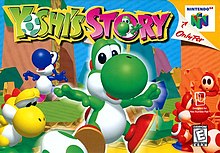
Back يوشي ستوري Arabic ياوشيس ستورى ARZ Yoshi's Story Catalan Yoshi’s Story German Yoshi's Story Spanish Yoshi’s Story Finnish Yoshi's Story French Yoshi's Story Italian ヨッシーストーリー Japanese 요시 스토리 Korean
| Yoshi's Story | |
|---|---|
 North American box art | |
| Developer(s) | Nintendo EAD |
| Publisher(s) | Nintendo |
| Director(s) | Hideki Konno |
| Producer(s) | Takashi Tezuka |
| Designer(s) | Katsuya Eguchi |
| Programmer(s) | Masaru Nii |
| Artist(s) | Shigefumi Hino |
| Composer(s) | Kazumi Totaka |
| Series | Yoshi |
| Platform(s) | |
| Release | |
| Genre(s) | Platform, action-adventure |
| Mode(s) | Single-player |
Yoshi's Story[a] is a 1997 platform game published and developed by Nintendo for the Nintendo 64. It was released in Japan in December 1997, and worldwide the following year.[1] It was re-released on the Wii's Virtual Console service in October 2007,[2] and for the Wii U's Virtual Console in early 2016. It was also re-released on the Nintendo Switch Online + Expansion Pack in October 2021.
Development was handled by Nintendo EAD and led by Hideki Konno and Takashi Tezuka. It was the first Yoshi platformer not to be produced nor directed by Shigeru Miyamoto, although he contributed design ideas. The score was composed by Kazumi Totaka, who provided the voice of Yoshi in the game. As a follow-up to the Super NES game Yoshi's Island, it continues within the platform genre with similar gameplay. However, Yoshi's Story is more puzzle-oriented, with most challenge being tied to the strategic achievement of a high score. Taking place within a pop-up storybook, the game features vivid pre-rendered 3D graphics, illustrating worlds that are crafted from different materials, such as cardboard, fabrics, plastic, and wood. The game received mixed reviews from critics, who responded unfavorably to its low difficulty level, although its art style, audio, and graphics were praised.
Cite error: There are <ref group=lower-alpha> tags or {{efn}} templates on this page, but the references will not show without a {{reflist|group=lower-alpha}} template or {{notelist}} template (see the help page).